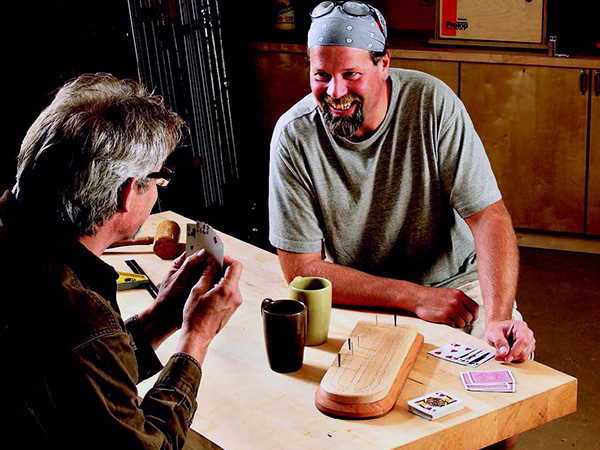
Making one or multiple classic cribbage boards is easy with this project plan and a drilling guide that perfectly locates the more than 260 holes.
During those long, cold winters I spent growing up along the shores of Lake Vermilion in the far north of Minnesota, one of the ways that we wiled away the long dark evenings was playing cribbage. Young or old, it made no difference. It is such a popular pastime “up North,” that I would not be surprised if it was the primary way most of my friends learned to count and to add. (One of the ways you earn points in cribbage is by combining cards that add up to 15 or 31.) I can still hear someone counting out “that’s 15 for two and a pair is four!” If you can believe it, this design was originally sent to us from a person who lives even further north than where I grew up. Bruce Beatty, a fire department training officer and woodworker from Orangeville, Ontario.
A beginner can make this woodworking project, and using the cribbage board drilling-guide template from Rockler makes drilling the holes a snap. One of the best features of this cribbage board is the built-in storage space for your playing cards and cribbage pegs, but you could simplify this project even more by only making the playing surface and storing your cards and pegs separately.
Starting with the Middle
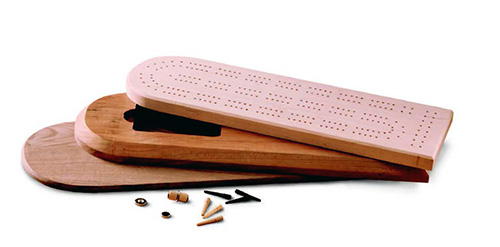
Using Bruce’s CAD drawings as my starting point, I quickly did what all woodworkers do when working from a plan supplied by someone else: I changed it! After a couple of test cuts in 3/4″ stock, I was worried that the recess that stores the cards could become a problem. When I routed the recess, the amount of material remaining seemed a little too thin for my liking. I could, of course, make that piece from 7/8″-thick stock, but it looked a bit bulky. So, after a bit of noodling, I decided to rout the card recess completely through the 3/4″ stock and glue a 1/4″-thick piece of black walnut to the bottom as a base. To my eyes, that dark base visually anchored the cribbage board to the table and provided a nice three-layered look to the project. (You can choose either solution.) I also decided to use a pivot hinge and included a small magnet to keep the board closed.
With those choices made, I went ahead and cut blanks from which to form the three pieces that make up the cribbage board: the core, base and playing surface (pieces 1, 2 and 3). You can find the sizes for the blanks in the Material List on the following page. While the choice is up to you, I made the base from walnut, the core from cherry lumber and the playing surface from maple.
You have another choice to make now: if you are going to make several cribbage boards (say, perhaps to give away as presents…) I recommend that you make two separate templates — one sized for the core and base, and one for the playing surface. If you are only going to make one or two cribbage boards, simply make the template for the core. (You can lay out and make the playing surface easily enough without resorting to pattern routing if you are only making a few of these cribbage boards.)
The core template needs to locate the positions of the rotating hinge, the peg storage hole, magnet hole and the card storage recess I talked about earlier. And the best way to make the card recess hole includes pattern routing as one of the steps. Look to the Drawings on the following page to give you all the dimensions and locations for these details. Consider this as a tip: I made my templates from 1/2″ MDF because it is easy to work with and inexpensive. But more than that, 1/2″ thickness, in my opinion, is better than 1/4″ for pattern routing with a bearing-guided router bit because the bearing can be shielded within the thickness of the MDF. Take your time and make the template (or templates) accurately…any mistakes here will show up on your finished project.
Making Some Sawdust
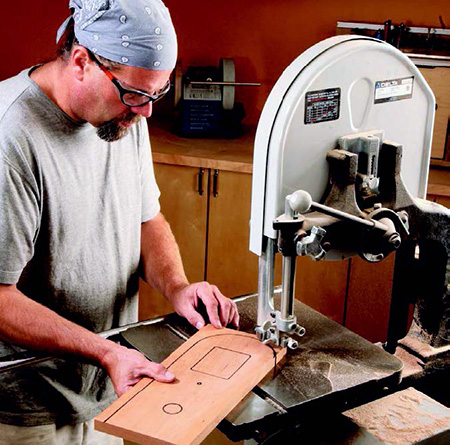
Grab the core blank you cut earlier and the core template and trace the shape onto your blank. As shown in the photo above, if your blank is a bit oversized, align the template with two edges of the blank when you trace the shape, so it will reduce your cutting on the band saw.
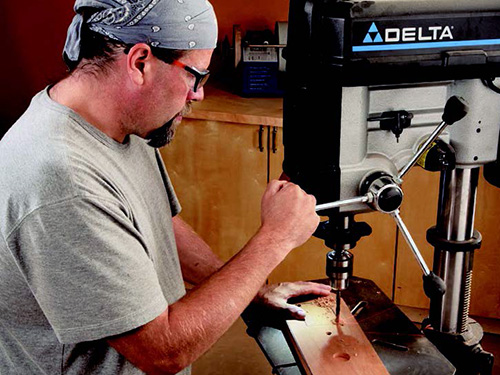
When you’ve completed the band saw cut, step over to your drill press to bore a 1/2″-deep hole for peg storage and a two-step hole for the pivot hinge. When forming this two-step hole with Forstner bits, make the shallowest hole (5/8″ diameter by 1/16″ deep) first. Then you can easily align the deeper hole (3/8″ diameter by 3/8″ deep) by using the spur depression left by the first Forstner bit. Go ahead and drill the small hole for the magnet at this time, too.
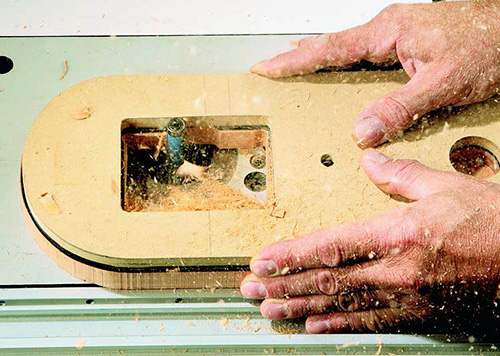
Next, drill out the four corners of the card recess as shown in the photo. I used a handheld jigsaw to remove most of the waste from the card recess. When that is done, use a couple of pieces of two-sided carpet tape (not too much!) to secure the core template onto the core. Then chuck a 1/2″ bearing-guided pattern routing bit into your router table.
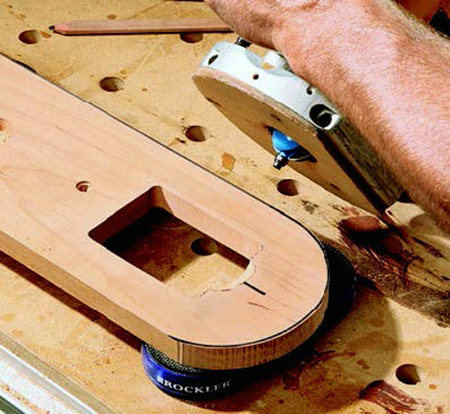
Trim the card recess opening as shown. Then you can shape the outside of the core in the same manner. Cutting the curved shape at the end of the board with a router bit can be a bit tricky. You may be better off just sanding it smooth to your marked line, although I did OK by climb-cutting around the radius. Pop the template off of the core and set it aside for now.
Building on the Base
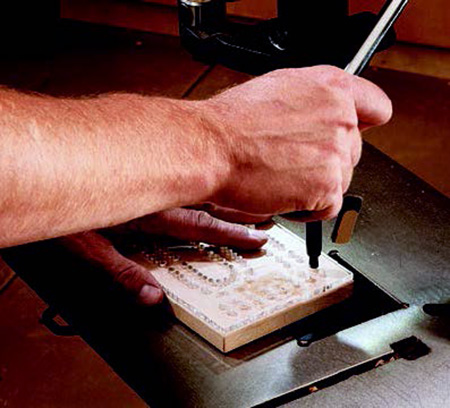
Grab the base blank that you made earlier. Use the core (or, if you wish, the core template) to trace its shape onto the base blank. Use the band saw to cut the base to shape, but stay outside of the lines by a strong 1/16″ and set it aside with the core.
It’s now time to move on to the playing surface. If you made a template for this piece, grab it and the blank you cut earlier and go through the same shaping process you did with the core. (But don’t drill the peg holes yet; just make the outside shape.) If you did not make a template, you have a bit more layout to do, but it shouldn’t take long. Once the piece is shaped, grab the drilling jig you ordered and the self-centering drill bit and head over to the drill press. (What’s that? You didn’t order the drilling jig and bit? What are you, crazy? Let me strongly affirm, here and now, that you should not try to make this project without the jig…sorry. It is simply too hard to get all those holes placed properly without it. There are 260 or so holes to drill — that’s a lot of alignment!)
Again, reach for the double-sided tape and secure the drilling jig to the playing surface. Chuck the bit in the drill press and start drilling. But go slow! Even with the jig as a guide, I found that I had to take my time and be very deliberate about this process. It was also useful to free any tiny wood chips that clog the centering sleeve on the drill bit.
When that was done, I bored the pivot hinge hole on the back of the playing surface and the magnet washer hole and set it aside. Grabbing the core one more time, I chucked a 3/4″ cove-cutting bit into a handheld router and shaped the finger opening on the edge of the card recess as shown in the photo, center right. Then I glued the base onto the core and let the glue cure. Once the glue was dry, I used the pattern-routing bit to trim the base to perfectly match the core.
You are almost done. Changing out the pattern-routing bit in the router table for a large chamfer bit in the router table, I shaped the top edge of the core so that the inside of the chamfered profile matched the size of the playing surface. With that cut completed, lower the chamfer bit and shape the top edge of the playing surface with a slight bevel. Now it’s time for sanding. Work up through the grits to at least 180, but I recommend 220-grit. With this done, take a moment to secure the magnet and washer in their holes with five-minute epoxy.
For finish on this project, I used a natural Watco oil. Try not to get too much into the peg holes — even though that is hard to avoid. Three coats of oil and a rubdown with some paste wax, and you’ll have a proper finish on your gameboard.
The last thing you need to do is assemble the two pieces by driving the pivot hinge into the core and tapping the playing surface down onto the hinge. You’ll notice that the magnet pulls the two pieces into alignment when you get them close to the right spot. Nifty, huh?
Now all you need to do is find a partner and a deck of cards, and you’ll have yourself a game going in no time! Fifteen for two, anyone?
Click Here to Download the Drawings and Materials List.
Cribbage Board Project Parts and Accessories
Rockler JIG-IT Track Style Cribbage Board Drilling Template #34540
3/8″ Roto Hinge #36244
Self-Centering Bit #69007
Wooden Pegs #21741
3/8″ Magnet #32907
3/8″ Magnet Washer #38348







